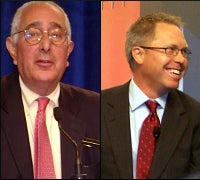 |
| From left: Panel moderator Ben Stein and HP’s Bruce Dahlgren Photos: David Needle |
SAN FRANCISCO — It says something about the corporate customers’ concerns about energy and costs savings when the biggest maker of printers pushes a plan to do more with less.
At an event here in San Francisco, HP (NYSE: HPQ) today rolled out an ambitious Managed Print Services (MPS) it says is guaranteed to save companies money. The HP Printing Payback Guarantee is a customized program that involves meeting with HP reps to assess a company’s imaging and printing environment.
HP said it then calculates an overall printing cost savings based on this specific enterprise-wide solution deployment that will be implemented by HP. After one year of full implementation, HP will conduct a second assessment. If the customer has not achieved the projected savings, HP promises to make up the difference.
HP is also offering the “HP Page Plan,” a pre-bundled solution with the same MPS objectives.
“This is paradigm-shift stuff,” Bruce Dahlgren, senior vice president of worldwide sales for HP’s printer group, told InternetNews.com. “The opportunity is a perfect storm because you have the economic issues, IT looking for innovative solutions, and energy savings. HP is in the best position to address all that.”
Of course, HP was one of the main forces behind the printer sprawl that bedevils many companies today, promoting personal printers when there was less concern about costs as well as environmental impact. An emphasis of the MPS initiative is redeployment of printers to more shared, centralized locations, instead of in every office or cubicle.
It’s also potentially lucrative for HP. MPS is an $18.7 billion market, according to recent IDC figures and growing at a rate of 4 percent a year according to HP’s estimates combined with outside market analysis.
But if getting a better handle on an enterprise’s printing costs can help a business save money, it’s a proposition likely to fall on receptive ears.
“It’s absolutely clear there’s no downside to this,” TV personality and economics commentator Ben Stein told InternetNews.com after the event. Stein was hired to moderate a panel discussing the announcement, and compared the benefits of MPS to the onset of the interstate highway system enabling far more efficient transportation.
Still, HP’s Dahlgren concedes competitors could also rightfully promise to save customers money on energy and efficiency if they buy the latest printers. But he claims HP’s program takes a “bigger picture” approach by assessing the overall infrastructure.
“The majority of companies don’t even know what they have that’s old or outdated,” he said.
Kevin Moe, a strategic business planner at Intel (NASDAQ: INTC), said the chip giant was an early MPS customer and is already realizing benefits for 1,800 printers in use worldwide.
“It’s brought us significant cost savings and 60, 70, even 80-percent reduction in our carbon footprint power since we converted from an aging fleet from another supplier,” he said.
Part of that savings comes from knowledge. With MPS, Kevin says Intel now knows how many pages per month and per quarter it’s printing and even who is doing the printing. “Now I can see that 11 percent of our total printing is color and that’s 50 percent of our cost of printing. That’s something we have control over and can drive change.”
Another MPS customer, STMicroelectronics, used its data from MPS to devise an innovative solution to cutting printing costs: It said it positioned its black and white printers 20 meters from most work spaces and the color ones 40 meters to discourage their use.


